|
Welcome!
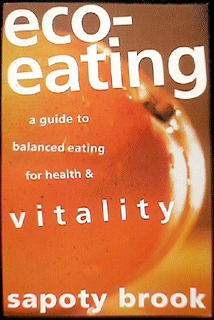 Read
this web page and you will learn about: Read
this web page and you will learn about:
Why Eco-Eating?
My Background and Introductory Explanations.
Why Mineral Balancing?
Understanding the CaPNaK Chart.
Where are the Food Groups?
Your Symptoms of Food Imbalancing.
Your Benefits from Intentional Imbalancing.
How you can Eat a live or raw food diet in a healthy way.
Which is your Food Chakra?
Getting your Raw Benefits.
What is the Core Raw Diet?
The Five Basic Rules of Raw Eating.
Food Combining and other issues.
There are
no links for the headings above because I want to encourage you to read this page
from beginning to end. (You
can purchase an MP3 download of the audio recording of this page here
if you want to have a copy to listen to at your leisure.)
Why Eco-eating?
ECO-EATING is the know how to select
foods to create the body and mind you want, and reach optimum health without cooking.
My name is Sapoty Brook and I'm
hoping that what I've to tell you now will transform your body and mind. It can
help you heal yourself, and heal the planet.
 |
For now I'm willing to call
myself a Rejuvenation Consultant. I'm interested in rejuvenating you and, through
rejuvenating you, helping the planet and the environment.
My Background and Introductory
Comments.
My university degrees are in science
and electrical engineering with a master of science degree in neural modeling
. I've also worked and lived for 30 years with the live or raw food approach to
eating and have written the book titled eco-eating. |
How do I go about applying the
idea of eco-eating in my life?
We will get to that soon. First of all I must describe a little background detail
to make sure that you understand the process behind the eco-eating way. This will
be divided into two parts.
The first part describes the methods and benefits of mineral balancing, and how
to use it in your life to help you achieve optimum health and create the body
and mind you want.
The second part describes how to apply mineral balancing to a live or raw food
diet and how to eat a raw food diet in a long term healthy way, easily without
any problems or difficulties.
However, let me say at the beginning that what I'm about to describe is a demanding
and intensely transforming practice. You may find at first that you have difficulties
in applying what I have to say, but as time goes on, its like driving a car, you'll
find it easier and easier, and eventually you'll find it so easy that you'll wonder
why everyone isn't doing it!
Its of the utmost importance however that anyone with any doubts about their physical
condition must follow these guidelines only under medical supervision - that especially
includes pregnant and breast feeding women, small children or the sick or elderly.
Its also important to maintain a good exercise program that keeps your blood flowing
and the tissues oxygenated.
From an emotional and spiritual
point of view its very difficult to apply the information if there is a backlog
of unprocessed emotions in your mind. So I would suggest that anybody who feels
on the edge emotionally at all, should either find some counseling or do some
breath work and meditate . I highly recommend that you practice meditation daily
to provide a stable basis for the application of this system and method of eating.
|
 |
The information here is based on
my book "eco-eating". "Eco" relates to ecological and its
important to realize that the ecological benefits of this diet and approach are
just as significant as the health benefits. Your garbage and energy used in the
kitchen and in the production of your food will be reduced to an absolute minimum
and this will have great benefits for the environment especially if its adopted
by many many people.
Why Mineral Balancing?
Now, the first of the two main
parts of this information page is on mineral balancing. I developed a CaPNaK'
chart for the understanding of this. The name CaPNaK is a conglomeration of the
abbreviated names of the minerals shown on the chart. You can see here below an
illustration of the chart for a clearer understanding of what I am describing.
Understanding the CaPNaK Chart
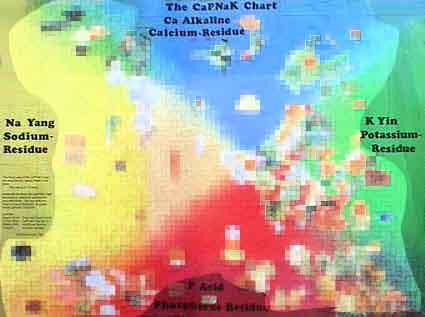 |
In case you need to refer to
it, click on this blurred copy of the CaPNaK Chart to open it in a new window.
You can buy a clear copy of the
CaPNaK Chart either as a image download or as a printed colour poster. See the Go Deeper web page to purchase
the chart and accompanying Symptoms
Diagram and a Benefits Diagram |
I
developed the CaPNaK Chart after several years of working with a raw food diet,
experimenting and trying to optimize a raw food diet and finding difficulties
in achieving balance. Then, when I eventually discovered how to achieve balance
in the raw food diet, I found that I was confronted by a lot of people who really
and truly believed that this was impossible. So the CaPNaK Chart came out of this
confrontation.
The basic idea is that in food there are four main minerals: sodium, potassium,
calcium and phosphorus. These minerals occur in much larger quantities in food
than the other minerals, and they have very very significant and ubiquitous effects
on the body and mind.
With these four minerals its well known that sodium and potassium can be seen
as a balancing pair as they both play a very important role in the fluid balance
in the body.
There is more sodium outside the cells and more potassium inside the cells and
so the amount of fluid distributed between the inside and outside of the cells
is influenced by this sodium/potassium balance.
Other factors influenced by the sodium/potassium balance are, for example, muscle
contraction and nerve transmission, - so these two minerals are very fundamental
to the body and mind.
The other two minerals, calcium and phosphorus are also in balance. Phosphorus
in the form of phosphates has a major acidic affect on the body, whereas calcium
is the major alkaline mineral.
Calcium stored in the bones is the alkaline buffer for the body. When the body
is overloaded with acid
foods some alkaline calcium is withdrawn from the bones to help re-balance the
acidity of the phosphates and restore the body to acid/alkaline balance.
Slight disturbances in the balances of both these pairs of minerals have big effects
on the body and mind.
I wanted to express these balances graphically so that it would be very accessible
to you in terms of understanding and achieving rebalancing of the minerals in
your body. Now, the problem I ran into, of course, was that there are four dimensions
here - the four minerals require four dimensions - so graphically speaking its
impossible to display these four dimensions.
 |
So the approach I took was to take
into account the balanced ratio between the two pairs of minerals. This then enabled
me to take each food and subtract out the balanced ratio for each pair of minerals.
This left the remaining residual amount of mineral that created an imbalance.
For example consider a banana - a banana is high in potassium and low in sodium.
A certain balanced ratio between potassium and sodium is fairly ideal for the
average body and if that's taken out of the banana then there is an excess of
potassium left over. |
So if I then show on the Chart how
much potassium is left over it gives a clear indication of the imbalancing effect
of the banana. That excess potassium must be dealt with in some way otherwise
it creates symptoms and effects in the body mind.
This way I reduced the graph to two dimensions. I plotted the positions of the
foods according to the residual amounts of minerals remaining after the balanced
amounts of calcium-phosphorus and sodium-potassium were taken out.
I was then able to plot two directions on the Chart and therefore show the unbalancing
effect of each food by its position or distance and direction from the center
of the Chart.
So once armed with this basic concept I went to the food composition tables provided
by various governments and other scientific groups. I took the average mineral
contents of each food and put the data through my computer and determined the
position of each food on the chart. Hence I was able to construct the CaPNaK Chart.
|
That was 10 years ago now, and
since then I and many other people have been using the CaPNaK Chart and finding
great benefits from understanding what effect particular foods are having on the
body and mind.
You will notice if you look at the
CaPNaK chart that there are four colours. The colours indicate where each mineral
predominates. For example, in the blue area the calcium dominates and therefore
the foods are mainly alkaline, in the yellow area the sodium dominates and the
foods are mainly Yang.
|
 |
In the area between the blue and the yellow you would call the foods Yang/Alkaline
so neither is dominant.
You will see a rectangular area of a different shade around the center. Any foods
outside that area have been squashed in towards the center so that they fit on
the chart. For those who understand, the scale is linear inside and logarithmic
outside the rectangular area.
I've taken the liberty of associating Yang with sodium and Yin with potassium
as a means of bridging the gap between the scientific nutritional approach and
the eastern style approach to nutrition, especially macrobiotics.
However there are some foods which are not positioned according to how one would
expect from a macrobiotic viewpoint. In this case I've leant towards the scientific
approach because of its fundamental foundation in the atomic understanding of
matter.
Where are the Food Groups?
Now if you look carefully at the
Chart, for example look in the bottom left hand region in the Yang/Acid area,
many meats and fish are grouped together in that area.
Different food groups tend to group in different areas in this chart. So by knowing
where the different food groups are located you'll be able to start to understand
the different effects of the food groups on the body and mind.
|
For example nuts, grains and
legumes are mainly located in the lower right hand region, in the Yin/Acid area.
Fruit, you'll notice, is located just right of the center in the Yin or potassium
direction, and dairy products are located in the upper left hand region, in the
Yang/Alkaline direction.
Seaweed and also some green vegetables
are located in that area as well. There are also many green vegetables in the
upper right hand area, in the Yin/Alkaline direction.
|
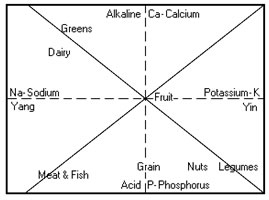 |
Foods
stay in approximately the same position whether or not they are organic.
Foods are shifted around the chart by additives. For example whole meal bread
is in the Yang/Acid region even though wheat is in the Yin/Acid region. Why? Because
sodium salt is usually added to the dough.
Similarly white bread is above whole meal bread on the chart because the milk
solids add more calcium than phosphorus.
You will also notice that tea, coffee, white sugar and oils are at the center
of the chart. They provide no residual minerals because they contain almost no
minerals. This does not mean they are healthy. They are unhealthy for other reasons
than their mineral content.
Your Symptoms of Food Imbalancing.
I supply along with the CaPNaK Chart
a Symptoms Diagram and a Benefits Diagram. You will notice at the center of the
Symptoms Diagram and Benefits Diagram the same four directions that are shown
on the CaPNaK Chart, calcium, phosphorus, sodium and potassium and these are in
the same directions as they are on the chart. See the example below for a clearer
understanding of what I mean.
 |
On the Symptoms Diagram there are
various symptoms listed for being imbalanced in each mineral direction.
Taking the opposite pairs of symptoms for example the pair for calcium and phosphorus,
you'll be able to see that there are some opposite or complementary effects. |
For example the calcium foods will
having a calming affect on the body, in overdose, making you excessively calm,
tranquil, lazy, or careless.
Whereas the excessive phosphorus foods will have the effect of making you anxious,
paranoid, restless, or worried. That can be good to a certain extent but when
taken too far can have negative effects on your body and mind.
Due to our conditioning and cravings, almost all of us are in some ways out of
balance in regard to these four main minerals and therefore we all tend to have
some symptoms.
So we can all benefit by checking out the Symptoms Diagram and finding out where
our symptoms tend to lie. Now some of our symptoms will be always present, and
some will be sometimes present and sometimes not.
So first of all, the idea is to find which symptoms are the most pervasive ones
for you and which direction tends to be the most important for you to try to rebalance.
Say for example you find that you
often feel very cold and have bags under your eyes and maybe some swelling of
the ankles. Then you could conclude that you have got symptoms reminiscent of
an overdose of sodium or an under dose of potassium. So by eating more foods in
the potassium direction you would rebalance that.
For example, Referring to the food
chart look at foods in the potassium direction. You could choose bananas for example
as a good food to reduce those symptoms of sodium overdose and potassium under
dose.
The other way you can approach the problem is also to reduce the high sodium foods
that you may be eating. For example you may be eating too much cheese or too much
meat which you'll see on the Yang side of the CaPNaK Chart.
|
Lets say tomorrow you eat too
many bananas, say you eat four bananas in a row. You may get a bloated belly,
indigestion, feel faint and dizzy. These are Yin overdose symptoms.
What will you do? You'll need an
antidote. So you run your finger across the chart from bananas through the center
to the diametrically opposite side. |
 |
Look for a healthy raw food in that region, for example celery is ideal. Three
sticks of celery will balance up the bananas, and half an hour later your negative
symptoms will be gone.
When you get the Symptoms Diagram its worth taking some time out now now and to
have a look at the negative symptoms and find out which direction you think you've
gone too far in.
You may find that there is one particular direction of the sodium/potassium balance
and one direction of the calcium/phosphorus balance and you'll get the idea that
you have eaten too far into one region of the chart.
So have a look at the foods in that region and consider what times you might eat
those sorts of foods and whether you tend to get more of those negative symptoms
at those times or soon after those times.
And look at the foods in the opposite region, diametrically opposite through the
center of the Symptoms Diagram, and you might find a lot of foods you don't have
much affinity with - that you don't enjoy very much.
So the idea here is that we have to use our intellect to overcome our conditioning
and preferences which have been instilled in us since childhood from our parents
and our culture.
Your Benefits from Intentional
Imbalancing.
That's a look at the negative effects
of foods. Conversely, there are corresponding positive effects and they are shown
on a corresponding Benefits Diagram I supply in my with the CaPNaK Chart. The
Benefits Diagram has the same four directions from the center corresponding to
the four main minerals. On the Benefits Diagram you would see the positive effects
listed around the outside.
 |
For example, if you wanted to
do some sport, say yoga, then up in the alkaline direction towards the top you'll
see the second line from the top says "helps you relax and become tranquil".
Well, that would be good preparation for doing yoga wouldn't it? So you could
eat foods in that direction a couple of hours before doing yoga.
Also, eating over in the right hand
side, the Yin or potassium side, you'll see about fourth point down "loosens
up your body". So eating in the potassium or Yin direction would be a good
idea to prepare for yoga as well: help you stretch into those asanas.
So eating in the calcium/potassium
direction or the Yin/Alkaline direction, in other words in the upper right area
would be good preparation for yoga. |
Look at the Yin/Alkaline region of the CaPNaK Chart and see that you could, for
example, have a salad with chives, okra and broccoli in it. Or a little bit closer
to the center you'll see oranges, so you could have a couple of oranges.
The further the food is from the center the faster it will take you into the particular
mind body state associated with that direction from the center.
Each direction from the center: up, down, left, right or the oblique directions,
has a corresponding mind/body state.
For example, foods down in the bottom right hand region will put you into a studious
thinker type personality and even a thinker type body if you eat them long enough.
Foods in the bottom left hand region will put you into a gung-ho workaholic state
for getting things done.
And foods in the top left hand region will put you into what I would call party-animal
mode, where you can really have a good time at parties and be more social and
outgoing.
And foods at the top right hand region will put you into what I would call care-bear
mode, where you would make a good listener or carer.
So you can experience how foods can influence the mind state as well as the body
state. And you can start to use the foods to put yourself in the right frame of
mind for whatever activity you want to be engaged in.
You can also use the chart to create warmth or coolness in your body. For example,
if you have got to work hard on a hot day then on the positive effects list on
the left hand side corresponding to sodium you'll see it says "cools you
down".
So if you look at the corresponding sodium direction on the CapNaK Chart , celery,
for example, could be used to cool down on a hot day, and conversely bananas over
on the right hand side, high in potassium, will warm you up.
You can imagine that your current body-mind state is at a particular point on
the chart. You might describe yourself as a bit Yin/Alkaline for example. The
foods you eat move your body-mind state around the chart. You can choose which
way to go.
Another important point for our
times, considering the runaway obesity of western society, is the fact that the
foods in the calcium direction will help you gain weight and the foods in the
phosphorus direction will help you lose weight.
So by eating low calorie - low kilo joule - acidic foods you can help your body
lose weight.
For example, looking at the CaPNaK chart green peppers, cauliflower, mung sprouts,
asparagus, brussels sprouts, peas and mushrooms are foods all reasonably low in
calories and have an acid residue in the body. Therefore they reduce the ability
of the body to absorb and hold fat. |
 |
This is because calcium in the intestine
and blood stream helps the body absorb fat from the intestines and deposit it
into fatty tissue. So the slight absence of calcium makes it more difficult for
the body to retain or gain weight.
So here again it's worthwhile to sit down and study the positive effects that
you can create in each direction. Take time to think about what you do in your
life and how you can use your food to enhance your performance in whatever you
do.
That concludes the general discussion of the CaPNaK Chart. Now I want to proceed
to how to eat a live or raw food diet in a long term healthy way.
How you can eat a live or raw food diet in a long term healthy way?
Why would one bother going against
the mainstream attitudes and try to eat a predominantly live raw food diet?
First of all, lets look at the problems of our society in terms of health. Billions
of dollars are being spent on health every year. Many people are having enormous
health problems and spending a large proportion of their income and tax on maintaining
their health, whether it be through herbs, supplements, all the way through to
drugs and eventually to surgery.
Now, the US Surgeon General, who would be considered to be the No. 1 doctor in
the world, has publicly stated that 70% of diseases are nutritionally related.
These are the words of an incredibly conservative member of the establishment.
Even he is saying that 70% of all diseases are nutritionally related.
So, that gives us the option of reducing our disease rate enormously if we can
improve our nutrition.
You will probably be familiar with the fact that over the last couple of decades
there has been a real drive to reduce the amount of fat that people eat in their
diet.
The "sad diet" or the standard Australian diet is essentially, about,
50% fat intake. The other extreme was created in the well known Pritikin diet
which recommended only about a 10% FAT intake.
Current government recommendations are to eat about a 30% fat intake and some
heart and diabetes groups recommend about 20% fat intake.
The basic approach to almost all these lower fat diets is to say that people should
move onto more carbohydrate in their food rather than the protein foods which
tend to carry the saturated fats and cholesterol along with them.
Also, another reason for moving onto the carbohydrates is to provide a nice clean
source of fuel for the body in the form of carbohydrates.
Carbohydrates don't produce the same acidic effects which a high protein intake
has on the body due to the nitrates and uric acid formed by protein metabolism.
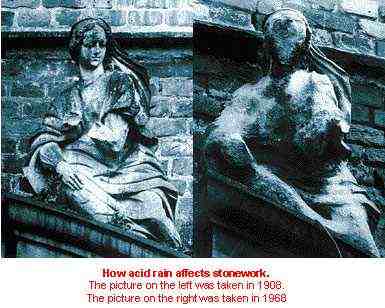 |
However when we look at the
CaPNaK Chart we see that the high carbohydrate foods tend to be down in the lower
portion of the chart in the acid area.
This is very important because it's well known that acidity in the diet leaches
calcium from the bones and will contribute to osteoporosis. Osteoporosis is a
growing plague in our society and should be taken seriously by everybody. |
People in high grain eating societies
such as the Japanese have a long history of fear of osteoporosis in old age. A
lot of Japanese men are very frightened that they will slip over during their
walk home from the pub and break their pelvis and have real problems.
The solution is not to go back to a high meat diet because meat is equally as
acidic in terms of the calcium/phosphorus balance, but even more acidic in terms
of the high protein content, creating extra acidity.
So when we are faced with this question of osteoporosis we have to look outside
the conventional meat-grain-beans type of approach to eating.
So would we move to dairy products? Well, OK, everybody knows that dairy products
are high in calcium but actually the high protein in dairy products has an acid
effect and reduces the alkaline/calcium benefits of the dairy products. This applies
particularly to adults who do not utilise much protein for growth.
Also, dairy products tend to stimulate excretion of a lot of mucous in the digestive
tract, especially the nose and throat, providing a breeding ground for various
bacteria and viruses, and contributing to colds and infections.
Dairy products also tend to create allergic reactions, and many people are lactose
intolerant especially as they get older, as they move out of childhood.
However, if you look at the CaPNaK Chart there are some green vegetables that
are higher in the Alkaline direction than dairy products.
For example, just above dairy products there are spinach, kale and silverbeet.
So these green vegetables, when eaten in sufficient quantities, are an excellent
replacement for dairy products in the diet as a source of calcium.
There are also many other high calcium green vegetables you can use, which are
not so Yang, such as broccoli and okra. See the Yin-Alkaline quadrant of the CaPNaK
chart.
After all that putting down of meat and grain, beans and dairy products, you might
be wondering "well what can I eat to get some energy?".
Obviously vegetables don't contain enough energy to enable you to thrive. So there
is only one option left for getting the energy and that is fruit.
Which is your Food Chakra?
Before we look more closely at fruit,
I want to talk about the different levels of nutrition.
Its important to realise that different practitioners have different views depending
on their basic approach to nutrition. To provide a map so you can understand where
people are coming from, I've developed a set of seven levels which I call the
food chakras.
Starting with the lowest those levels are:
Junkivore- in other words a junk food eater.
Carnivore- avoiding junk food but eating a lot of meat.
Piscavore- avoiding meat and eating a lot of fish or poultry.
Vegetarian- avoiding flesh and tending to eat a lot of grain and dairy
products.
Macrobiotic- shying away from dairy products but still heavily into grain
and beans.
Vegan- renouncing animal products, eating more fruit and salads in the
diet than the macrobiotic, but still eating cooked foods daily.
Symbiotic - which is a raw food eater who eats mainly fruit as the major
source of energy, and usually eats raw vegetables, nuts and seeds.
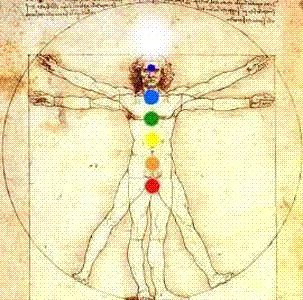 |
Now, as we progress up these levels
we actually do have to give up certain foods or reduce them down to a minimum
in our diet. For example, someone who is a macrobiotic has stopped eating red
meat.
This process of moving up the food chakras is abhorrent to many people because
it means giving up some foods that they currently enjoy and are used to eating.
But the essential point is that, in this process of giving up something that we
enjoy in the short term, we get enormous benefits in the long term. We experience
greater health and longevity, and generally enjoy life more due to our state of
health. |
Its a case of giving up a short
term pleasure for a long term benefit. So if you are not willing to give up the
short term pleasures for long term benefits then perhaps what I have to say is
fairly irrelevant to you.
However as people mature they tend to realise the importance of this approach.
So they are the people that this information is directed to. Are you one of them?
Getting Your Raw Benefits.
Getting back to the raw food approach, the idea is that you get your major source
of energy from fruit. I recommend that 70% of the diet, say 7 serves out of 10
would be fruit and 25% of serves would be greens, green leaf vegetables. The remaining
5% would be nuts, seeds and perhaps a very small quantity of animal products.
The first thing that comes to peoples minds when they hear about this sort of
approach is "there is too much sugar in all that fruit - it's terrible".
You have got to remember that the sugar in fruit is not free sucrose. It is fructose,
which has a much more gentle effect on the body and bloodstream - it comes into
the bloodstream much more slowly.
Update: I want to acknowledge
that research is showing that added fructose in food and drink is extremely
unhealthy and may be the primary cause of cardiovascular disease.
However, the fiber in fruit makes
fruit-fructose super healthy because (paraphrasing Prof.
Robert H. Lustig, MD, UCSF; Sugar: The Bitter Truth, 2009):
1. The fiber (in fruit) slows down
the absorption of fructose from your intestine.
2. The fiber increases the speed of movement of the digesting fruit to the ileum,
at the end of the small intestine, where a protein is released that helps reduce
appetite.
3. The fiber keeps some free fatty acids in the food until the colon where they
are turned into short-chain fatty acids which help lower insulin levels.
So fruit-fructose is an excellent
source of energy, superior to glucose, provided the fruit is eaten whole in a
grazing style, and not juiced or dried. This is entirely consistent with the eco-eating
raw food style that I teach. I am pleased to see that my recommendations are being
scientifically confirmed. After 30 years[2010] of eating this way my fasting triglyceride
level remains at a healthy 1.2 mmol/L, and my urate (uric acid) is 0.25 mmol/L which is ideal according fructose experts.
Also the sugars in fruit are mainly bound into the cellular structure so, again,
they are released slowly and gently into the blood stream. The beneficial cellular
structure of raw food is destroyed by cooking.
Slow release of sugars from raw food keeps your insulin level low. This is a major
health benefit also aimed at by the popular, but higher protein, Zone diet.
|
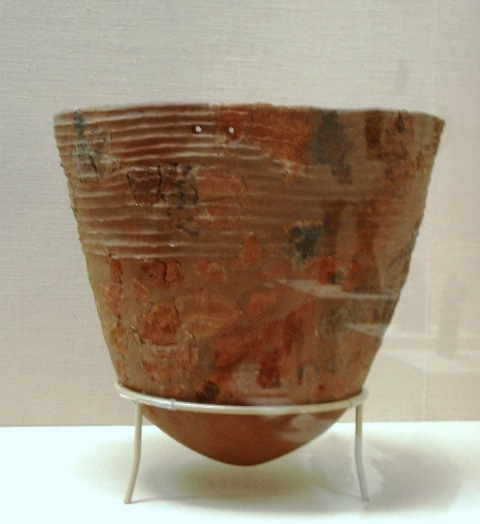
Jomon pottery: the dawn of cookilling
vegetables and grains in pots 10,000 BCE. |
Another way to keep the blood sugar
stable and insulin level low is to graze. Forget the 3 meals a day belief system.
With the raw food approach 6 to 8 meals a day is much better. Eat a sweet or savory
meal depending on your taste at the time.
It's important to realise that one of the major reasons for moving into a raw
food diet is because any cooking, any heating of any foods above 50 degrees centigrade
or half way to boiling point destroys the enzymes in food.
The enzymes in food are very important because they actually help you digest the
food.
Now if you destroy the enzymes in food then the body has to produce all the digestive
enzymes and acids that are required to digest the food. This puts a big load on
the pancreas and stomach. |
So when we take the load off the
pancreas and stomach we are actually taking the biochemical load off the endocrine
system. Since the endocrine system is also responsible for the immune system,
for immunity, we actually allow some of that biochemical energy to be redirected
from digestion over towards immunity. Hence our immunity escalates much higher
on a raw food diet.
Some people reduce cancers and eliminate cancers from their body while eating
the raw food way. Perhaps their immune systems become strong enough to destroy
cancer cells. In addition to reducing the risk of osteoporosis, improved resistance
to infection and cancer are other likely long-term health benefits of a raw food
diet.
Some people prefer to follow their instincts in choosing raw foods. This can be
assisted by touching and smelling the available foods. However many people also
need to have an intellectual methodology to help over-ride their negative conditioning.
To enable people to move into a raw food diet without any worries about the danger
of deficiencies and so on, I've developed a simple diet which I call the Core
Raw Diet.
What is the Core Raw Diet?
Now the core raw diet consists of
5 bananas, 6 large oranges, 4 sticks of celery, 1/2 kilo of broccoli or equivalent
dark green leaf vegetables and 2 handfuls of nuts and seeds every day. This diet
is just under 20% fat.
Think of these foods as your staples,
just like bread, meat and milk might once have been.
Amazingly, according to food composition data, this diet will give full nutrition
to a 70 kilogram person, with the exception of vitamin B12. Smaller people could
get full nutrition on less food.
However the Core Raw Diet is low in calories, low in kilo joules so in effect
if an active 70 kilogram person ate those proportions of fruits, vegetables and
nuts then they would tend to lose weight. |
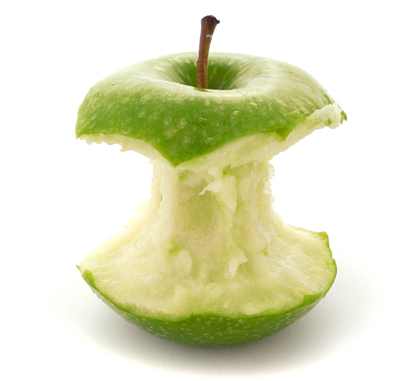 |
So, on top of the Core Raw Diet,
you should add whatever fruits and vegetables you wish to add, especially those
that are fresh and in season.
Now, in addition to these five food components there are five basic rules you
must follow if you want to be successful in eating the raw food diet.
The Five Basic Rules of Raw Eating.
The first rule is to have enough
fruit to eat - this is incredibly important! Most people who switch to a raw food
diet find it very difficult to eat sufficient quantities initially.
Now that's a great thing because we are all so used to restricting ourselves and
not being able to eat this or that and trying to keep our weight down or whatever.
Well, in this case, you can go for it - eat heaps of fruit especially, and its
vitally important to eat 5 pieces of fruit before 10.00 a.m. - that will get you
off to good start for the day, get your blood sugar level nice and smoothly high,
and you'll be ready to zoom through the day.
Morning grumpiness and cravings are often due to low blood sugar, so try to always
get yourself off to a good start.
A small person who doesn't want to lose weight must eat a minimum of 12 pieces
of fruit a day. By "a piece of fruit" I mean fruit equivalent to a medium
sized apple. A big person must eat a minimum of 15 pieces. More if you are active.
The second rule is to eat 1/2 kilo or 500 grams of dark greens. Now that's really
important to get your sufficient calcium intake and also iron and many other trace
minerals. Considerable protein can also be obtained from dark green vegetables.
The third rule is to eat at least 4 sticks of celery a day. Now this is also very
important. 4 sticks of celery a day will give you your basic sodium requirements.
Have more on hot days.
If you don't get your basic sodium requirements you'll go Yin and you'll have
some high potassium / low sodium symptoms such as weakness, dizziness, fainting,
headache or feeling passive.
During the transition to a raw food diet some people experience a cleansing crisis
as stored toxins are released from their tissues. The negative symptoms can often
be dramatically reduced by eating more salty vegetables such as celery.
 |
So its quite important to keep
those 4 sticks of celery going in every day spread through the day, especially
around noon, because they are an important cooling food. |
And the fourth rule is to have two
handfuls of nuts and seeds a day. Now I would particularly recommend men to at
least include one handful of green pumpkin seeds because of their high zinc content.
When you are doing a high level of physical activity then you may need to eat
3 or 4 handfuls of nuts and seeds a day to provide a higher fat and protein intake.
You must also increase your intake of other raw foods to provide sufficient energy
and water etc.
The fifth rule is to have a source of B12 in the diet. After about 5 to 10 years
on a very low animal food diet you'll probably run low in your stores of B12.
Few people produce enough B12 in their digestive tract to maintain their stores.
So its important, I think, right from the word go, to pre-empt that, and introduce
some food source of B12.
You can get B12 from animal products such as fish. One or two hundred grams of
fish each week is a good idea.
If you don't want to eat animal foods then I would suggest that you try a teaspoon
of spirulina every day and/or take a B12 supplement, because it's quite difficult
or impossible to get B12 in sufficient quantities from ordinary vegetables.
There are some fermented foods such as tempeh or kombucha that you may be able
to get a decent amount of B12 from. It's important to realise that B12 comes in
different forms and not all are readily utilised by humans so it's necessary to
check your sources.
Think carefully about the B12 issue early on because if you go deficient in B12
then you may suffer nerve damage, brain damage or become anemic. You should also
get a B12 check with your doctor every couple of years and take immediate nutritional
action if you drop below the medical minimum.
Now returning to the chart with this idea in mind of the high fruit based diet,
fruit is slightly Yin of the center. Almost all fruits clumped very specifically
in this area, slightly to the right of the center.
However rather than worrying about becoming too Yin on a fruit based diet it's
possible to balance up a Yin based diet with some Yang raw foods. Celery, which
is off to the left hand side in the sodium/Yang area, is ideal for this purpose.
|
That's why it's included in
the Core Raw diet and also why I suggest that everybody on a raw food diet should
eat 4 sticks of celery a day. Alternatively, any of the other Yang greens such
as spinach for example are also very good especially considering that they contain
a high calcium content as well.
Now it's important to realize that
some greens and fruit are Yin/Alkaline so these are important calcium sources
as well. So for example Broccoli is a major Yin/Alkaline green vegetable and oranges
are an important Yin/Alkaline fruit.
|
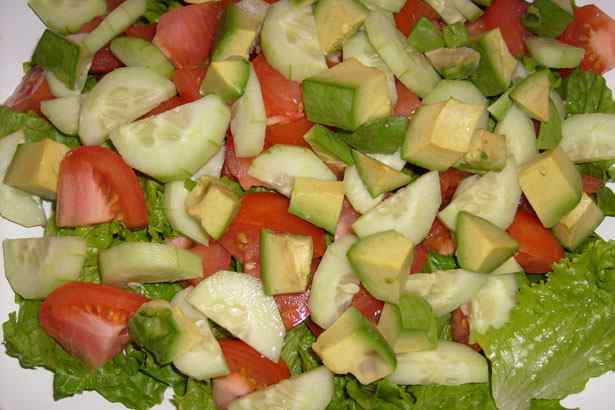 |
People may be surprised to hear
that oranges are alkaline because everyone knows that oranges are so acidic. But
it's important to understand that the acidity is in the juice - that orange juice
is the acidic component.
So, if you have an orange, try to have the whole orange as there is a lot of alkaline/calcium
in the pulp which balances out the acidity of the juice. However, I don't wish
to imply that you should eat the peel. It may cause tooth problems.
It's interesting that juice generally tends to be more acidic than the fruit or
vegetable it's juiced from. For example you'll see on the chart that carrots are
balanced between the acid and alkaline areas, just to the left of the center in
the yang direction. Carrot juice is immediately below the carrots, well into the
acid area of the chart.
So it turns out to be a fallacy that Carrot juice is alkaline. Its certainly more
alkaline than many seeds and nuts, but it definitely does not have a nett alkaline
effect on the body.
Now I don't recommend eating large quantities of nuts and seeds in a raw food
diet. Nuts and seeds are quite acidic - they are high in phosphates.
Some people believe that almonds are a good source of calcium. However, the high
phosphate content of the almonds means that more calcium is dragged out of the
bones, by the phosphate, than is deposited.
So if you want to have a source of fat that is alkaline rather than acidic then
the only one that I know of which is viable is unhulled tahini.
Now, unhulled tahini, which is made from unhulled sesame seeds, is above the center
of the CaPNaK Chart right up high in the alkaline area.
And in the opposite direction, down in the acid area, you'll find hulled sesame
seeds. So it's important to know that tahini made from hulled sesame seeds is
actually a very acidic food, whereas unhulled tahini is a very alkaline food.
So don't use hulled tahini as a way of avoiding osteoporosis, as it will actually
contribute to osteoporosis.
You will now understand that in the core raw diet I mentioned earlier, there is
an acid-alkaline balance between oranges and bananas, and also between broccoli
and nuts and seeds. All these foods are Yin and are balanced by the celery which
is yang. So, long-term CaPNaK balance and control can be maintained by eating
these foods.
In guiding people on a raw food diet I encounter a few very common problems. I
would like to briefly mention those so that as you try the raw food diet you'll
bear them in mind and avoid the pitfalls.
Food Combining and other issues.
The first problem is bad food combining.
If you eat a lot of vegetables and fruit together then you may start to suffer
from gas build up in your intestines. Now this is very bad for digestion of food,
and reduces nutrient absorption from the intestines.
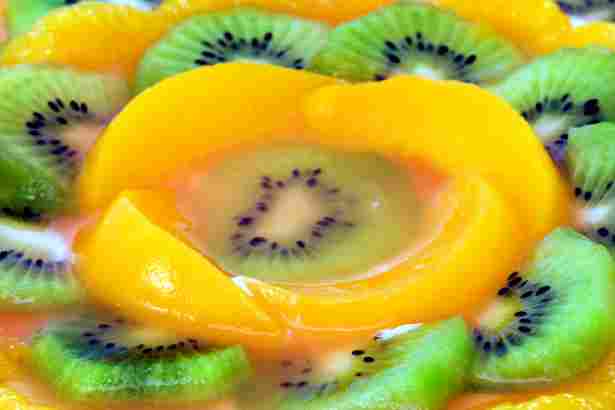 |
When a portion of the intestine
is filled with gas it means that the intestine wall is not in full contact with
the food. This reduces the absorption of nutrients.
So it's very important to avoid creating gas from bad food combining. If you notice
excessive gas forming in your intestines then experiment with your combinations
of fruit with other foods to find the causes. Unripe fruit such as bananas can
also create gas.
|
Another factor in food combining
is that you may eat cake or other grain based carbohydrates from time to time,
just due to your conditioned cravings or at a social event. Then it's important
to avoid eating any fruit for at least two hours after eating carbohydrate. Then
you won't get the fruit mixing with the carbohydrate in the intestines and causing
fermentation and gas.
Another problem that people run into is that they go low in sodium. This happens
with many healthy diets and not only a raw food diet. People who go off all sodium
supplements such as soy sauce, miso, high sodium dairy products and meat, find
they start to get the Yin symptoms.
For example, indigestion often occurs when your body gets so low on sodium that
the muscles in their intestines can't contract properly. Also water is not well
absorbed and diahorrea can occur. It's quite important to avoid this low sodium
problem by religiously eating at least 4 sticks of celery a day.
Another problem is that people become low in blood sugar. This happens when they
don't eat enough fruit. Often people find that they have difficulty in eating
more than about 5 pieces of fruit a day just because of the volume.
So one way you can increase your fruit intake is to decrease the amount of fluids
you drink. You can provide all the fluids you need by eating fruit. Remember that
the fruit's about 90% water, so if your eating 12 - 15 pieces fruit a day then
your getting around 2 litres of water from the fruit!
So it's not actually necessary to drink water at all unless you are in a physically
demanding situation or perhaps in extremely hot weather. You can satisfy your
body's needs for water by eating a lot of fruit.
That will also reduce the possibility of becoming low in blood sugar. Because
the bloodstream gets a constant supply of sugars as the fruit's digested.
Now the indicators to watch for with low blood sugar are that you start to slur
your speech, your hands start to shake, or you lose some coherence of thought.
Conversely, a great benefit of a high fruit diet is that thinking can become very
clear as a result of the supply of sugars to the brain. The brain is a major burner
of sugar in the body.
Another problem that often occurs on a raw food diet is that you start to go low
in Vitamin B. This is because you have not eaten enough green vegetables. The
broccoli and dark greens are an excellent source of Vitamin B.
So if you start to develop cracked lips, or cracked corners of the mouth, or start
to become low in energy, that may be a result of going low in Vitamin B due to
not eating enough green vegetables.
|
Finally a typical problem is getting dry skin. Often this is due to not eating
enough nuts and seeds and therefore not getting enough fats in their food intake.
So if you take into account all
these problems and take appropriate action as soon as you begin to notice the
symptoms then you'll find that you can move into a raw food diet very easily.
You can then start to feel the benefits
of raw food in your daily life. You can start to use foods, according to the CaPNaK
balance and control principles, to influence your body and mind states to achieve
optimum performance in whatever you do. |
 |
I hope you have gained helpful knowledge
by reading the above.
For more information and learning
tools about these approaches to nutrition there are various media available on
the Go Deeper link below.
|




 Read
this web page and you will learn about:
Read
this web page and you will learn about:
















